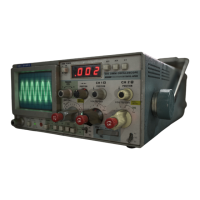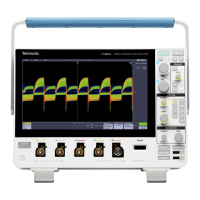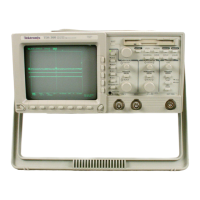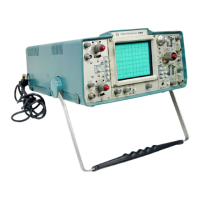Theory of Operation-314 Service
The system is reset when RESET button S337 is
pushed. +5 volts is applied to differentiating network
C335, R336, C332, and R332. The positive spike appearing
at pin 1 terminates any sweep that is in progress and the
spike appearing at pin 7 resets the system.
Sweep Magnification and Positioning
XI0 magnification of the sweep is achieved by chang-
ing the attenuation ratio of the output sawtooth. For an
unmagnified sweep,
R366, R367, and R368 provide about
20X attenuation of the sawtooth, reducing the sweep
amplituhle from about +6 volts to about f0.3 volts. The
deflection sensitivity of the crt is such that this amplitude
gives one screen width of deflection, provided that the
output sawtooth is centered about ,ground, which cor-
responds with screen center.
When the Sweep Mag Switch,
S367, is switched to the
XI0 position, R367 is disconnected, changing theattenua-
tion to about 2X, increasing the sawtooth amplitude to
about +3 volts. Since only one-tenth of this amplitude is
accepted by the oscilloscope, the displayed segment
appears as an
XI0 magnification. In XI0 position of XI0
Mag switch, all sweep rates indicated on the panel are
magnified by a factor of ten.
POSITION Control R370 provides an adjustable
change in the conduciton of Q373 to alter the dc level of
the output signal. Positioning range is sufficient to move
any portion of a magnified sweep into the on-screen
window.
EXT HORlZ
@
General
To operate the horizontal in the amplifier mode, the
TIME/DIV switch is rotated counterclockwise into one of
the two EXT HORIZ positions. In this condition, the Sweep
Generator circuit is disabled (including the crt blanking
gate), and the output of the Trigger Preamplifier is
connected to the Horizontal Amplifier circuit through the
common-base amplifier.
Input Stage
A
signal applied to input connector J300 is passed to
the gate of Q313A, through switches S300 and S305.
Q313A, Q313B, Q318, and Q320 form a non-inverting
operational amplifier, which is operated as an X2 gain
amplifier to isolate the next amplifier stage from the high
impedance input circuitry.
LEVEL control R331 is disconnected from the gate of
Q313B.
Output Stage
The output from the collector of Q318 is connected to
the emitter circuit of Q400, which is a common-base
amplifier. The signal produced at (2400 collector is in
phase with the applied signal. Two steps of gain selection
are available. In XI gain position of theTIME/DIV switch,
the deflection factor is about 200
mV/Div. In XI0 gain
position, the deflection factor decreases to about
20 mV/Div. As R385B is varied, more resistance is added
to the emitter circuit, decreasing the gain. 13405 adjusts for
no beam position shift of the crt display when rotating the
VAR control. The output signal of this stage is applied to
the horizontal amplifier.
HORIZONTAL AMPLIFIER
@
General
The horizontal amplifier accepts a horizontal sweep
voltage from the sweep generator, amplifies it, and applies
the resulting push-pull signal to the horizontal deflection
plates of the crt. During EXT HORIZ operation, the input
from the sweep generator is disconnected, allowing EXT
HORIZ input signals to be amplified and applied to the
horizontal deflection plates. Fig. 3-10 isa blockdiagram of
the Horizontal Amplifier stage.
Emitter-Follower Amplifier
The signal from either sweep generator or EXT HORIZ
amplifier is applied to the emitter-follower stage, Q430.
This stage provides a high input impedance to prevent
loading the preceding stage.
Common-Base Amplifier
The signal output of Q430 is passed to the output
amplifier through the common-base amplifier, (2435.
Q435 isolates the input circuit from the output amplifier.
When the crt display mode is in Store, R429 is short
circuited by the Store switch, S500A, to increase the gain
of the horizontal amplifier, correcting for the crt deflection
sensitivity change that occurs when the display is shifted
to the stored state.
Output Amplifier and Output Inverter Amplifier
Assume that a positive-going sweep signal is arriving at
the input of the amplifier. The positive-going voltage is
applied to
(2440 base. (2440 and (2442 form a non-inverting
amplifier circuit, and a positive signal is developed at Q442
collector. This signal is amplified and inverted by
(2450,
providing a negative-going signal for the left deflection
plate. The collector of
Q450 is also applied to feedback
circuit R443A-R443B-C443. The changing voltage of Q450
causes most of the signal current required by the input
signal to flow through the R443A-R443B-C443 network.
Therefore, only a very small part of the input signal is seen
at the base of 0440.
REV.
A,
AUG.
1975

